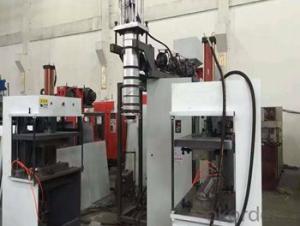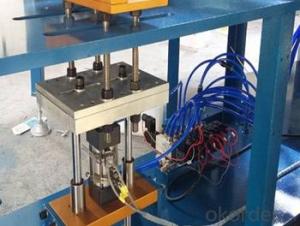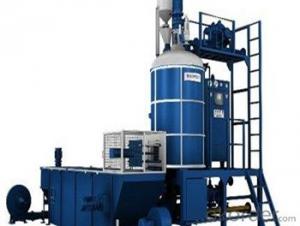FRP pultruded grating with Anti-flammable with no toxic on sales
- Loading Port:
- Tianjin
- Payment Terms:
- TT OR LC
- Min Order Qty:
- 1 m.t.
- Supply Capability:
- 100000 m.t./month
OKorder Service Pledge
OKorder Financial Service
You Might Also Like
PRODUCT DESCRIPTION
Pultruded grating is made by a particular assembly process, which using “I” shape as its main load-bearing and special rod to go through the bearing bar. Pultruded grating include the standard grating and the custom grating, the custom grating can be designed to meet customer’s requirement or special using condition by changing the shape, size and space of the bearing bars, the surface can be covered with lozenge panel, grit panel, or added the anti-slippery sand directly.
FRP pultruded grating has the most characteristics of molded grating, but it has its distinct advantages, it has very high fiberglass content in the loading direction, so it has very high load capability, it has more superiority when used at wide span, so that the basic support will be decreased and the project cost will be reduced accordingly.
SPECIFICATION
Thickness (mm) | Bar width (mm) | Open space (mm) | Open rate (%) | Approx weight (kg/m |
25.4 | 15.2 | 22.8 | 60 | 13.2 |
25.4 | 15.2 | 15.2 | 50 | 15.9 |
25.4 | 15.2 | 10.1 | 40 | 18.5 |
25.4 | 40 | 10.8 | 21 | 14.5 |
38.1 | 15.2 | 22.8 | 60 | 15.8 |
38.1 | 15.2 | 15.2 | 50 | 19.1 |
38.1 | 15.2 | 10.1 | 40 | 22.4 |
50.8 | 25.4 | 25.4 | 50 | 16.6 |
50.8 | 25.4 | 12.7 | 33 | 21.1 |
CHOICE FOR PULTRUDED GRATING
Resin: GP resin, ISO resin, VE resin, Phenol resin
Color choice: Yellow, gray, green, custom color
Surface choice: Groove surface, grit surface, lozenge cover surface
FEATURES
a. Anti-corrosion and anti-rust
b. Light weight and high strength
c. Anti-flammable
d. Anti- fatigue
e. Safe and anti-slippery
f. Anti-ageing
g. Easy of maintenance
h. Excellent electromagnetism property
i. Good economic benefit
FIELDS SERVED
Sewage treatment,
water supply and drainage,
chemical industry,
oil industry,
power engineering,
pulp and paper,
construction engineering,
spinning, marine engineering.
APPLICATION
Operation terrace,
stair walkway,
ground floor,
trench cover,
sidewalk,
foot bridge,
equipment safety fence,
scaffold.
COMPANT DESCRIPTION
CNBM,China National Building Materials Group is a state-owned enterprise in charge of administrative affairs in china building materials industry. Established in 1984, CNBM is a large group corporation of building materials with total assets of 25 billion RMB and a total staff of 30,000.CNBM now owns 200 subordinating firms of solely owned and joint-venture companies.
CNBM International Corporation is one subsidiary of CNBM, we focus on offering good-quality products,professional service and complete solution to our customers. Strong delivery capacity, advanced technology& management, strong financing capability and excellent after-sale service are our advantages in sharing international market.
FAQ
1.Q:Are you factory or trading company ?
A:We are Factory produce FRP machines and FRP products.
2.Q:If can customized by customers requirements?
A:yes,we can produce the machine with customized size.
3.Q:How about the payment?
A:We accept any kind of payment.
4.Q:What is the guarantee?
A:Gurantee is one year.
5.Q:If you can training?
A:yes ,we can training in our factory also can send engineers to your factory training.
PICTURES
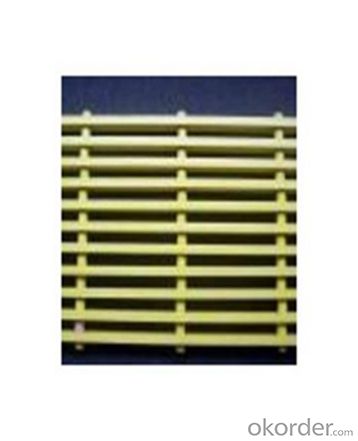
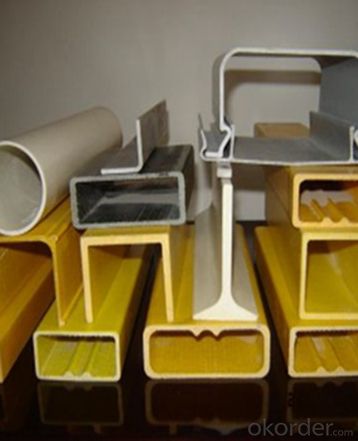
- Q:What are the environmental benefits of using FRP pultrusion profiles?
- FRP pultrusion profiles offer several environmental benefits. Firstly, they are lightweight, which reduces the energy required for transportation and installation compared to traditional materials like steel or concrete. This leads to reduced carbon emissions during the entire lifecycle of the product. Additionally, FRP is highly durable and resistant to corrosion, which means that it has a longer lifespan and requires less maintenance and replacement. This reduces waste generation and conserves resources. Moreover, FRP pultrusion profiles are non-toxic and do not release harmful chemicals or pollutants into the environment. Overall, their use contributes to sustainable practices and helps in minimizing the environmental impact of various industries.
- Q:Are FRP pultrusion profiles resistant to chemicals used in oil refineries?
- FRP pultrusion profiles have a high resistance to chemicals utilized in oil refineries. These profiles consist of a combination of strong fibers (such as fiberglass, carbon fibers, or aramid fibers) embedded in a polymer resin matrix. This unique construction grants them exceptional resistance to various chemicals commonly found in oil refineries. The polymer resin matrix used in FRP profiles can be carefully chosen to withstand harsh chemical environments. For oil refinery applications, vinyl ester or epoxy resins are often employed due to their superior chemical resistance properties. Additionally, FRP pultrusion profiles are inherently corrosion-resistant, unlike traditional materials like steel or concrete that deteriorate when exposed to aggressive chemicals found in oil refineries. This corrosion resistance ensures the long-term durability and reliability of FRP profiles in such environments. Furthermore, FRP profiles offer several other advantages in oil refinery applications, including a high strength-to-weight ratio, electrical insulation, non-magnetic properties, and ease of installation. These characteristics make FRP pultrusion profiles an ideal choice for various structural, piping, and equipment applications within oil refineries. However, it is crucial to consider the specific chemicals and concentrations involved in a particular oil refinery application. While FRP profiles generally exhibit excellent resistance to a wide range of chemicals, there may be highly concentrated or specialized chemicals that could potentially impact their performance. In such cases, it is advisable to seek guidance from FRP manufacturers or experts who can offer tailored solutions to meet the specific chemical resistance requirements of the oil refinery.
- Q:Are FRP pultrusion profiles resistant to oil and grease?
- Yes, FRP pultrusion profiles are highly resistant to oil and grease due to the inherent properties of the fiberglass reinforcement used in their construction. The composite material offers excellent chemical resistance, making it suitable for applications where exposure to oil and grease is expected.
- Q:Can FRP pultrusion profiles be used in pedestrian bridges?
- Yes, FRP pultrusion profiles can be used in pedestrian bridges. FRP (Fiber Reinforced Polymer) pultrusion profiles offer several advantages such as high strength-to-weight ratio, corrosion resistance, and durability, making them suitable for pedestrian bridge applications. These profiles can be customized to meet specific design requirements, ensuring the safe and efficient construction of pedestrian bridges.
- Q:Can FRP pultrusion profiles be used in the construction of modular buildings?
- Yes, FRP pultrusion profiles can be used in the construction of modular buildings. FRP (Fiber Reinforced Plastic) pultrusion profiles offer several advantages such as high strength-to-weight ratio, corrosion resistance, and design flexibility. These profiles can be easily fabricated into various shapes and sizes, making them suitable for modular building applications. Additionally, FRP pultrusion profiles are durable, low-maintenance, and exhibit excellent thermal insulation properties, making them a reliable choice for constructing modular buildings.
- Q:Can FRP pultrusion profiles be used in the construction of railway sleepers?
- Yes, FRP (Fiber Reinforced Polymer) pultrusion profiles can be used in the construction of railway sleepers. FRP pultrusion profiles offer several advantages that make them suitable for this application. Firstly, FRP pultrusion profiles are lightweight yet strong, making them ideal for railway sleepers. They have high strength-to-weight ratios and can withstand heavy loads, making them a reliable choice for supporting the weight of trains. Additionally, the lightweight nature of FRP profiles makes them easier to transport and install, reducing construction time and costs. Secondly, FRP pultrusion profiles are highly resistant to corrosion, which is a crucial factor for railway sleepers. Traditional materials such as wood or steel are susceptible to corrosion when exposed to moisture and chemicals. FRP profiles, on the other hand, are non-corrosive and do not require regular maintenance or replacement due to rust or decay. Furthermore, FRP pultrusion profiles offer excellent durability and longevity. They are resistant to UV radiation, extreme temperatures, and chemicals, ensuring a longer lifespan compared to traditional materials. This reduces the need for frequent replacements, resulting in lower maintenance and lifecycle costs. Moreover, FRP pultrusion profiles can be customized to meet specific design requirements. They can be manufactured in various shapes and sizes to fit different railway sleeper designs, offering flexibility in construction. Additionally, they can be made in different colors, allowing for aesthetic customization. Lastly, FRP pultrusion profiles offer excellent electrical insulation properties. This is crucial for railway sleepers, as they need to provide insulation between the train tracks and the ground to prevent electrical interference and ensure safe operation. In conclusion, FRP pultrusion profiles are a suitable choice for the construction of railway sleepers due to their lightweight, high strength, corrosion resistance, durability, customization options, and electrical insulation properties.
- Q:Can FRP pultrusion profiles be used in modular construction?
- Yes, FRP (Fiber Reinforced Polymer) pultrusion profiles can definitely be used in modular construction. FRP profiles are lightweight, high-strength, corrosion-resistant, and have excellent thermal and electrical insulating properties. These characteristics make them ideal for use in modular construction, where the emphasis is on prefabrication, transportation, and rapid assembly. The use of FRP pultrusion profiles in modular construction offers several advantages. First, their lightweight nature makes them easy to handle and transport, reducing logistical costs and effort. Second, their high strength-to-weight ratio ensures structural integrity while minimizing the overall weight of the modular components. This is particularly beneficial in applications where weight reduction is crucial, such as rooftop installations or areas with limited load-bearing capacity. Furthermore, the corrosion resistance of FRP profiles eliminates the need for regular maintenance and extends the lifespan of the modular construction. This is particularly advantageous in harsh environments, such as coastal areas or chemical processing facilities, where traditional construction materials like steel may deteriorate quickly. Additionally, FRP pultrusion profiles can be easily customized to meet specific design requirements. They can be manufactured in various shapes, sizes, and colors, allowing for flexibility in modular construction design. The profiles can also be easily integrated with other construction materials, such as concrete or wood, providing compatibility with existing modular systems. In summary, FRP pultrusion profiles are highly suitable for modular construction due to their lightweight, high strength, corrosion resistance, and customization capabilities. Their use in modular construction can enhance efficiency, reduce costs, and improve the overall performance and durability of modular buildings and structures.
- Q:Can FRP pultrusion profiles be used in renewable energy projects?
- Yes, FRP (Fiber Reinforced Polymer) pultrusion profiles can certainly be used in renewable energy projects. FRP pultrusion profiles offer a wide range of advantages that make them suitable for various applications within the renewable energy sector. Firstly, FRP pultrusion profiles are lightweight yet strong, making them ideal for use in wind turbine blades. The lightweight nature of FRP materials allows for increased efficiency in wind energy generation by reducing the load on the turbine, thus improving overall performance. Additionally, the high strength-to-weight ratio of FRP profiles ensures durability and longevity, even in harsh environmental conditions. Secondly, FRP pultrusion profiles exhibit excellent corrosion resistance, making them suitable for solar panel mounting structures and other components exposed to moisture and outdoor elements. This corrosion resistance ensures that FRP profiles maintain their structural integrity and performance over an extended period of time, reducing the need for frequent maintenance and replacement. Thirdly, FRP pultrusion profiles can be customized to meet specific project requirements, allowing for flexibility in design and functionality. They can be easily molded into complex shapes and sizes, enabling the creation of innovative and efficient solutions for renewable energy projects. Moreover, FRP materials are non-conductive and have excellent electrical insulation properties, making them suitable for use in electrical enclosures and support structures for renewable energy systems such as solar power plants. In conclusion, FRP pultrusion profiles can be effectively utilized in renewable energy projects due to their lightweight, strong, corrosion-resistant, customizable, and electrically-insulating properties. These characteristics make FRP profiles a reliable and sustainable choice for various applications within the renewable energy sector.
- Q:Are FRP pultrusion profiles resistant to hydrocarbons?
- FRP pultrusion profiles are known to be resistant against hydrocarbons. By combining different reinforcing fibers, such as fiberglass or carbon fiber, with a polymer matrix, FRP materials exhibit a high level of resistance to chemical corrosion, including hydrocarbons. This resistance makes FRP pultrusion profiles an excellent choice for applications that involve exposure to hydrocarbons, such as in the oil and gas industry, chemical processing plants, and fuel storage facilities. However, it is important to bear in mind that the level of resistance may vary depending on the specific resin used in the FRP material, as well as the concentration and temperature of the hydrocarbons present. Hence, it is advisable to consult with the manufacturer or supplier of the FRP pultrusion profiles to confirm their compatibility with the particular hydrocarbon environment at hand.
- Q:Can FRP pultrusion profiles be used in the oil and gas industry?
- Yes, the oil and gas industry can utilize FRP (Fiber Reinforced Polymer) pultrusion profiles. These profiles offer numerous advantages that make them suitable for use in this sector. To begin with, FRP pultrusion profiles exhibit corrosion resistance. They remain unaffected by harsh conditions such as saltwater, chemicals, and extreme temperatures, thereby avoiding rusting, corrosion, or degradation. Consequently, they prove ideal for offshore platforms, pipelines, and other oil and gas facilities where corrosion poses a significant problem. Moreover, FRP pultrusion profiles possess a high strength-to-weight ratio. Despite being lightweight, they possess remarkable strength, enabling efficient installation, transportation, and handling. This aspect is especially advantageous in the oil and gas industry, where reducing weight is crucial for enhancing operational efficiency and decreasing costs. Additionally, FRP pultrusion profiles can be customized to meet specific requirements. They can be manufactured in various shapes, sizes, and configurations, making them adaptable for diverse applications within the oil and gas industry. Whether it be for structural supports, grating, handrails, or other components, FRP pultrusion profiles can be tailored to perfectly suit the distinct needs of each project. Furthermore, FRP pultrusion profiles offer exceptional electrical insulation properties. This attribute holds immense importance in the oil and gas industry, where electrical safety is of utmost priority. By providing insulation and preventing electrical conductivity, FRP profiles reduce the risk of accidents and ensure the safety of both personnel and equipment. In conclusion, FRP pultrusion profiles have demonstrated their reliability, durability, and cost-effectiveness across various applications within the oil and gas industry. Their resistance to corrosion, high strength-to-weight ratio, customization capabilities, and electrical insulation properties make them an appealing choice for this demanding sector.
1. Manufacturer Overview |
|
|---|---|
| Location | |
| Year Established | |
| Annual Output Value | |
| Main Markets | |
| Company Certifications | |
2. Manufacturer Certificates |
|
|---|---|
| a) Certification Name | |
| Range | |
| Reference | |
| Validity Period | |
3. Manufacturer Capability |
|
|---|---|
| a)Trade Capacity | |
| Nearest Port | |
| Export Percentage | |
| No.of Employees in Trade Department | |
| Language Spoken: | |
| b)Factory Information | |
| Factory Size: | |
| No. of Production Lines | |
| Contract Manufacturing | |
| Product Price Range | |
Send your message to us
FRP pultruded grating with Anti-flammable with no toxic on sales
- Loading Port:
- Tianjin
- Payment Terms:
- TT OR LC
- Min Order Qty:
- 1 m.t.
- Supply Capability:
- 100000 m.t./month
OKorder Service Pledge
OKorder Financial Service
Similar products
New products
Hot products
Hot Searches
Related keywords


